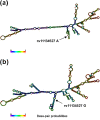A pri-miR-218 variant and risk of cervical carcinoma in Chinese women
- PMID: 23320911
- PMCID: PMC3585813
- DOI: 10.1186/1471-2407-13-19
A pri-miR-218 variant and risk of cervical carcinoma in Chinese women
Abstract
Background: MicroRNA (miRNA)-related single nucleotide polymorphisms (SNPs) may compromise miRNA binding affinity and modify mRNA expression levels of the target genes, thus leading to cancer susceptibility. However, few studies have investigated roles of miRNA-related SNPs in the etiology of cervical carcinoma.
Methods: In this case-control study of 1,584 cervical cancer cases and 1,394 cancer-free female controls, we investigated associations between two miR-218-related SNPs involved in the LAMB3-miR-218 pathway and the risk of cervical carcinoma in Eastern Chinese women.
Results: We found that the pri-miR-218 rs11134527 variant GG genotype was significantly associated with a decreased risk of cervical carcinoma compared with AA/AG genotypes (adjusted OR=0.77, 95% CI=0.63-0.95, P=0.015). However, this association was not observed for the miR-218 binding site SNP (rs2566) on LAMB3. Using the multifactor dimensionality reduction analysis, we observed some evidence of interactions of these two SNPs with other risk factors, especially age at primiparity and menopausal status, in the risk of cervical carcinoma.
Conclusions: The pri-miR-218 rs11134527 SNP was significantly associated with the risk of cervical carcinoma in Eastern Chinese women. Larger, independent studies are warranted to validate our findings.
Figures

Similar articles
-
Polymorphisms involved in the miR-218-LAMB3 pathway and susceptibility of cervical cancer, a case-control study in Chinese women.Gynecol Oncol. 2010 May;117(2):287-90. doi: 10.1016/j.ygyno.2010.01.020. Epub 2010 Feb 16. Gynecol Oncol. 2010. PMID: 20163849
-
Polymorphisms of the Interleukin 6 gene contribute to cervical cancer susceptibility in Eastern Chinese women.Hum Genet. 2013 Mar;132(3):301-12. doi: 10.1007/s00439-012-1245-4. Epub 2012 Nov 20. Hum Genet. 2013. PMID: 23180271
-
A genetic variant in pre-miR-27a is associated with a reduced cervical cancer risk in southern Chinese women.Gynecol Oncol. 2014 Feb;132(2):450-4. doi: 10.1016/j.ygyno.2013.12.030. Epub 2013 Dec 28. Gynecol Oncol. 2014. PMID: 24380734
-
Pri-miR-124 rs531564 and pri-miR-34b/c rs4938723 polymorphisms are associated with decreased risk of esophageal squamous cell carcinoma in Chinese populations.PLoS One. 2014 Jun 19;9(6):e100055. doi: 10.1371/journal.pone.0100055. eCollection 2014. PLoS One. 2014. PMID: 24945256 Free PMC article.
-
Association between miR-218 rs11134527 polymorphism and risk of selected types of cancer in Asian population: An updated meta-analysis of case-control studies.Gene. 2018 Dec 15;678:370-376. doi: 10.1016/j.gene.2018.08.053. Epub 2018 Aug 16. Gene. 2018. PMID: 30120974 Review.
Cited by
-
Quantitative assessment of pre-miR-218 rs11134527 polymorphism and cancer risk in Chinese population.Onco Targets Ther. 2015 Jul 24;8:1859-62. doi: 10.2147/OTT.S88480. eCollection 2015. Onco Targets Ther. 2015. PMID: 26244022 Free PMC article.
-
A miR-182 variant and risk of hepatocellular carcinoma in a southern Chinese population.Hum Genomics. 2020 Oct 15;14(1):38. doi: 10.1186/s40246-020-00289-x. Hum Genomics. 2020. PMID: 33059751 Free PMC article.
-
The association between polymorphisms in microRNA genes and cervical cancer in a Chinese Han population.Oncotarget. 2017 Sep 23;8(50):87914-87927. doi: 10.18632/oncotarget.21235. eCollection 2017 Oct 20. Oncotarget. 2017. PMID: 29152130 Free PMC article.
-
The associations and roles of microRNA single-nucleotide polymorphisms in cervical cancer.Int J Med Sci. 2021 Apr 7;18(11):2347-2354. doi: 10.7150/ijms.57990. eCollection 2021. Int J Med Sci. 2021. PMID: 33967611 Free PMC article. Review.
-
Multistep model of cervical cancer: participation of miRNAs and coding genes.Int J Mol Sci. 2014 Sep 4;15(9):15700-33. doi: 10.3390/ijms150915700. Int J Mol Sci. 2014. PMID: 25192291 Free PMC article. Review.
References
Publication types
MeSH terms
Substances
LinkOut - more resources
Full Text Sources
Other Literature Sources
Medical

